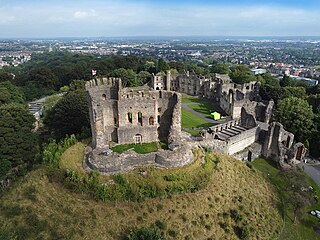
Dudley Castle is a ruined fortification in the town of Dudley, West Midlands, England. Originally a wooden motte and bailey castle built soon after the Norman Conquest, it was rebuilt as a stone fortification during the twelfth century but subsequently demolished on the orders of Henry II of England. Rebuilding of the castle took place from the second half of the thirteenth century and culminated in the construction of a range of buildings within the fortifications by John Dudley. The fortifications were slighted by order of the Parliament of England during the English Civil War and the residential buildings destroyed by fire in 1750. In the nineteenth and early twentieth century the site was used for fêtes and pageants. Today Dudley Zoo is located on its grounds.
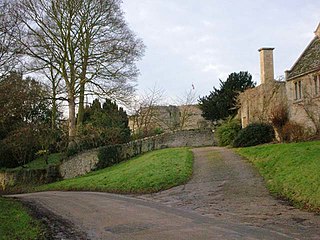
Barnwell Castle is a ruined castle, south of the town of Oundle, and north of the village of Barnwell, Northamptonshire. It has been designated by English Heritage as a Grade I listed building, and is a Scheduled Ancient Monument. It is under private ownership.
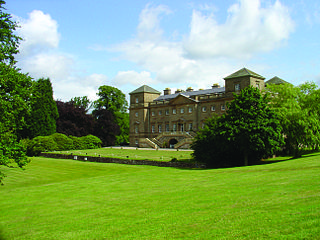
Hagley Hall is a Grade I listed 18th-century house in Hagley, Worcestershire, the home of the Lyttelton family. It was the creation of George, 1st Lord Lyttelton (1709–1773), secretary to Frederick, Prince of Wales, poet and man of letters and briefly Chancellor of the Exchequer. Before the death of his father in 1751, he began to landscape the grounds in the new Picturesque style, and between 1754 and 1760 it was he who was responsible for the building of the Neo-Palladian house that survives to this day.

Codnor Castle is a ruined 13th-century castle in Derbyshire, England. The land around Codnor came under the jurisdiction of William Peverel after the Norman conquest. The building is registered as a Scheduled Ancient Monument a Grade II Listed Building and is officially a Building at Risk.

Christchurch Castle is a Norman motte and bailey castle in Christchurch, Dorset, England. The earliest stonework has been dated to 1160. The castle's site is inside the old Saxon burh dominating the River Avon's lowest crossing.

Castle Goring is a Grade I listed country house in Worthing, in West Sussex, England about 4.5 miles northwest of the town centre.
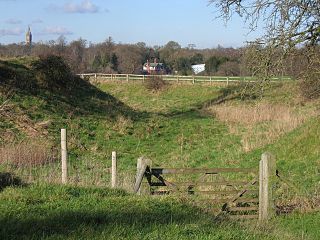
Aldford Castle is a motte and bailey castle in the village of Aldford in Cheshire. The motte is to the north of St John's Church, and the church stands on the site of an infilled bailey ditch.
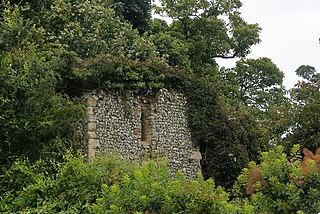
Benington Castle is a ruined castle in the village of Benington, near Stevenage in Hertfordshire, England at grid reference TL296236. It has been protected since 1936 as a scheduled monument.

Brandon Castle was sited overlooking the River Avon between the virtually adjacent villages of Brandon and Wolston in Warwickshire which in turn lie between the town of Rugby and city of Coventry.
Charlton Castle was a fortified manor house situated in Shropshire between Shrewsbury and Telford.
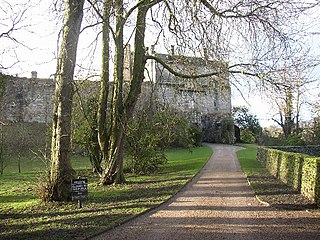
Cockermouth Castle is in the town of Cockermouth in Cumbria on a site by the junction of the Rivers Cocker and Derwent. It is a Grade I listed building and a scheduled monument.
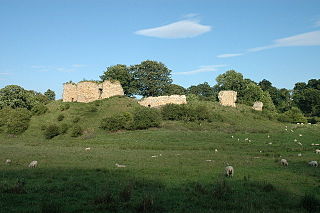
Mitford Castle is an English castle dating from the end of the 11th century and located at Mitford, Northumberland. It is a Scheduled Ancient Monument and a Grade I listed building, enlisted on 20 October 1969. The castle is also officially on the Buildings at Risk Register. The Norman motte and bailey castle stands on a small prominence, a somewhat elliptical mound, above the River Wansbeck. The selected building site allowed for the natural hill to be scarped and ditched, producing the motte.

Huntington Castle was situated in the village of Huntington in Herefordshire, England, 2+1⁄2 miles south-west of Kington.
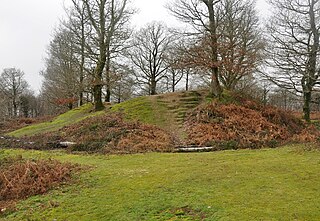
Hembury Castle is an Iron Age hillfort about a mile north-west of the village of Buckfast on the south-eastern edge of Dartmoor in Devon, England. The fort is about 178 metres above sea level on a promontory between the River Dart on the east and the Holy Brook, south-west. The slope down to the River Dart is very steep and is covered by Hembury Woods which is now a Site of Special Scientific Interest.
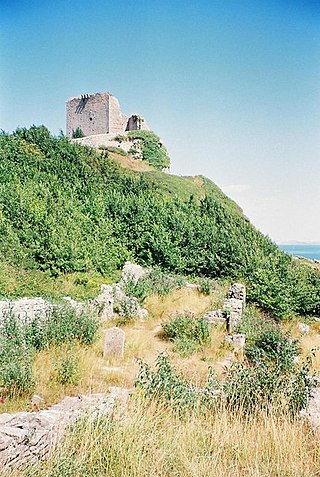
Rufus Castle, also known as Bow and Arrow Castle, is a partially ruined castle overlooking Church Ope Cove on Portland, England. Its name derives from King William II, known as William Rufus, for whom the original castle was built.
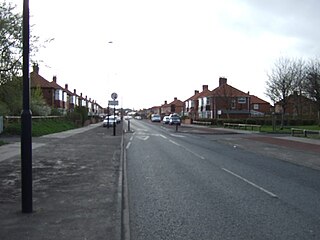
Milecastle 1 (Stott's Pow) was a milecastle of the Roman Hadrian's Wall. It was located near the (now disappeared) valley of Stott's Pow. Its remains are covered over, and are located beneath the recreation ground at Miller's Dene. Early excavations and investigations of Turret 0B were mistakenly interpreted as Milecastle 1. The Milecastle sits within the parish of Wallsend.
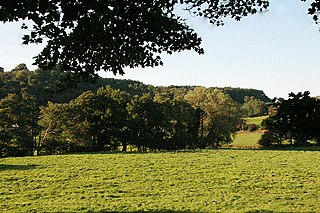
Heighley Castle is a ruined medieval castle near Madeley, Staffordshire. The castle was completed by the Audley family in 1233 and for over 300 years was one of their ancestral homes. It was held for Charles I during the English Civil War and was destroyed by Parliamentary forces in the 1640s. The ruinous remains comprise masonry fragments, mostly overgrown by vegetation. The site is protected by Grade II listed building status and is a Scheduled Ancient Monument. The castle is privately owned and is not open to visitors.
Craswall Priory was a Grandmontine priory in Herefordshire, England at grid reference SO27253770 dating from 1220 to 1225. The poor condition of the ruins mean that they are on Historic England's Heritage at Risk Register.

Weoley Castle is the remains of a fortified manor house located in the Birmingham district of Weoley Castle, a primarily residential area, in the English West Midlands. Owned by Birmingham City Council and administered as a community museum by Birmingham Museums Trust, it is a Grade II listed building and a Scheduled monument. The castle was on Historic England's Heritage at Risk Register, but was removed in 2009 following repair work.
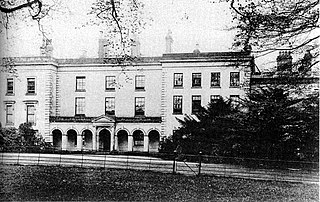
Stainsby House is an architecturally notable house in Horsley Woodhouse, Derbyshire, England. It was designed by Nottingham architect David Shelley, and built for the businessman Robert Morley, owner of Alida Packaging at Heanor Gate. The house was completed in 1974.



















